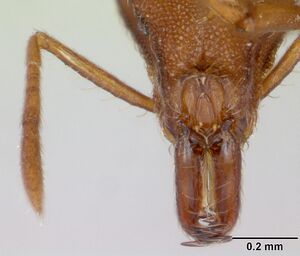Strumigenys covina
| Strumigenys covina | |
|---|---|

| |
| Scientific classification | |
| Kingdom: | Animalia |
| Phylum: | Arthropoda |
| Class: | Insecta |
| Order: | Hymenoptera |
| Family: | Formicidae |
| Subfamily: | Myrmicinae |
| Tribe: | Attini |
| Genus: | Strumigenys |
| Species: | S. covina |
| Binomial name | |
| Strumigenys covina Fisher, 2000 | |
Specimens have been collected in a range of forest habitats from rotten logs, litter samples, a rotting stump and foraging on vegetation.
Identification
Bolton (2000) - A member of the chroa complex in the Strumigenys scotti-group. S. covina is distinguished from other species in the chroa-complex by a lamellate upper scrobe margin and filiform hairs on pronotal humerus, petiole, postpetiole and first gastral tergite.
Keys including this Species
Distribution
Latitudinal Distribution Pattern
Latitudinal Range: -13.998° to -13.998°.
| North Temperate |
North Subtropical |
Tropical | South Subtropical |
South Temperate |
- Source: AntMaps
Distribution based on Regional Taxon Lists
Malagasy Region: Madagascar (type locality).
Distribution based on AntMaps
Distribution based on AntWeb specimens
Check data from AntWeb
Countries Occupied
| Number of countries occupied by this species based on AntWiki Regional Taxon Lists. In general, fewer countries occupied indicates a narrower range, while more countries indicates a more widespread species. |

|
Estimated Abundance
| Relative abundance based on number of AntMaps records per species (this species within the purple bar). Fewer records (to the left) indicates a less abundant/encountered species while more records (to the right) indicates more abundant/encountered species. |

|
Biology
Castes
Worker
Images from AntWeb
    
| |
| Worker. Specimen code casent0067549. Photographer April Nobile, uploaded by California Academy of Sciences. | Owned by CAS, San Francisco, CA, USA. |
Nomenclature
The following information is derived from Barry Bolton's Online Catalogue of the Ants of the World.
- covina. Strumigenys covina Fisher, in Bolton, 2000: 675 (w.) MADAGASCAR.
Unless otherwise noted the text for the remainder of this section is reported from the publication that includes the original description.
Description
Holotype. TL 3.0, HL 0.74, HW 0.53, CI 72, ML 0.32, MI 43, SL 0.44, SI 82, PW 0.35, AL 0.77. Characters of chroa-complex. Mandibles almost straight and at full closure parallel except at base. Basal half of proximal preapical mandibular tooth confluent with a lamella on inner margin which extends to base of mandible; in full-face view inner margin of lamella more or less straight. Upper scrobe margin a narrow lamella that is about half as wide as scape. Maximum diameter of eye about equal to maximum width of scape. Hairs on leading edge of scape slender and filiform. Cephalic dorsum with rows of curved narrow spatulate to spoon-shaped ground-pilosity, the upper scrobe margins fringed with a dense row of hairs which are the same shape and size as those on the dorsum. Cephalic dorsum with 6 simple standing hairs arranged in a transverse row of 4 close to the occipital margin and a more anteriorly situated pair. Pronotal humeral hair filiform with a pointed apex. Anterior margin of mesonotum with a pair of stout filiform hairs; posterior mesonotum with 2 additional pairs which are similar in shape but shorter. Propodeum with a pair of narrow filiform hairs immediately anterior of propodeal spines. Ground-pilosity on alitrunk sparse and similar in size and shape as on head. Dorsum of alitrunk in outline convex anteriorly and more or less flat posteriorly; posterior portion of mesonotum slightly depressed below the anterior margin of propodeum. Anterior mesonotum with a lamellate extension above the mesothoracic spracle. Propodeal tooth broadly triangular, lamellate and pointed apically; propodeal lamella relatively broad. Alitrunk dorsum reticulate-punctate; pleurae mostly smooth and shiny, peripherally reticulate-punctate. Disc of postpetiole smooth and shiny; in dorsal view, exposed cuticle of postpetiole node conspicuously broader than long. Ventral and lateral spongiform tissue of petiole and postpetiole moderately developed. Base of first gastral tergite with short costulae radiating on each side of a broad central clear area. Dorsal surfaces of petiole, postpetiole and gaster with standing filiform hairs. Colour dull yellowish brown.
PARATYPE WORKERS. TL 3.0, HL 0.74, HW 0.53, CI 72, ML 0.31, MI 42, SL 0.43, SI 80, PW 0.35, AL 0.78. (1 measured). As holotype.
Type Material
Holotype worker, Madagascar: 5.3 km. SSE Ambanizana, Andranobe, 15 ° 40 ' S, 49 ° 58 ' E, 425 m., 21. xi. 1993, sifted litter (leaf mold, rotten wood), rainforest, # 926 (32) - ll (B. L. Fisher) (Museum of Comparative Zoology). Paratype. 1 worker with same data as holotype but coded (33) - 9 (The Natural History Museum).
References
- Fisher, B.L. 2000. The Malagasy fauna of Strumigenys. Pp. 612-696 in: Bolton, B. 2000. The ant tribe Dacetini. Memoirs of the American Entomological Institute. 65:1-1028. (page 675, worker described)
References based on Global Ant Biodiversity Informatics
- Bolton, B. 2000. The Ant Tribe Dacetini. Memoirs of the American Entomological Institute 65
- Fisher B. L. 2003. Formicidae, ants. Pp. 811-819 in: Goodman, S. M.; Benstead, J. P. (eds.) 2003. The natural history of Madagascar. Chicago: University of Chicago Press, xxi + 1709 pp.

